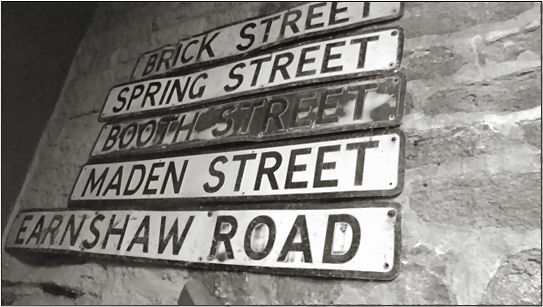Meetings of the Bacup Local Board of Health were first convened on the 17th of December 1863 and were initially held in the Mechanics Institute, moving to a purpose-built room over the shops in the newly opened market hall in August 1867. Bacup at this time was separated into five wards, Bacup, Greave, Rockliffe, Broadclough and Acre Mill.
Many of the streets at this time had no names, but in July 1865, the committee of the Local Board composed of local officials and prominent citizens, embarked on a thorough survey of the town’s streets and houses.
The committee estimated the number of street plate names required. They calculated they would need approximately 150 of these plates, crafted from durable enamelled iron and costing 3 shillings each. Additionally, they anticipated the need for 175 dozen door plates, with 14 plates assigned to each street. The total cost of this substantial project was estimated at £46.11s 3d.
They also acknowledged the need for consistency and clarity in the town’s street network. They stipulated that any streets with duplicate names in different neighbourhoods would be renamed to avoid confusion. Furthermore, if the committee deemed that an existing name could be improved upon, they would suggest an alternative that better reflected the street’s character or historical significance.
A discussion ensued as to whether they should do away altogether with the streets known as Queen Street, St James St, Rochdale Rd, and Church Street and just rename the roads Burnley Road, Todmorden Road and Rochdale Road, all going from Bulls Head Bridge to the boundaries of the district. Instead, they renamed Queen Street to Victoria Street, but, after some discussion, it was thought that, with the cornerstone of the new market hall having recently been laid, Market Street would be the better option.
The road leading to the market hall and police station known today as Bank Street, would, they decided, be named Police Street, and Church Street should extend only to Goose Hill and then become Burnley Road. In 1929, great amusement was caused in the Council chamber when it was decided to rename a triangular-shaped portion of the town as St James Square.
I had never really given much thought to the origins of some of the street, terrace or house names. Some are obviously named after their location and surroundings or their direction, i.e. Rochdale Road, Todmorden Road, Burnley Road. Newchurch Road takes its name from the road that led to the New Church, which had been built at Newchurch.
Many are named after people who were Gentlemen benefactors or landowners in Bacup, such as Hoyle, Holt, Maden and Whitaker
Councillors, Aldermen, businessmen, builders and mill owners, all feature in Bacup and Stacksteads street names. Shepherd Street, Mill Street, and Holmes Lane are all named after the Shepherd family of Holmes Mill. Marshalls Buildings in Stacksteads is named after William Marshall J.P, who was given the freedom of the borough in 1959. We even have a Prime Minister in that of Gladstone Street, named in honour of William Ewart Gladstone, who became Prime Minister for the first time in 1868. Gladstone Crescent and Gladstone Avenue were renamed along with Fairview Road in January 1983.
In Britannia, Sutcliffe, William and Ernest Street all named after the Sutcliffe family who owned Britannia Mill. Cowgill Street built and named after Harrison Cowgill, who also built parts of Gordon Street, using the masonry from Blackthorn Mill. Brearley Street, already mentioned elsewhere, takes its name from the firm of James Brearley whose son and grandson continued the business advertising “All Kinds of Buildings Contracted for (anything from a Cottage to a Castle)”.
Hartley Street was possibly built and named after building contractor George Hartley, who came to Bacup from the Yorkshire Dales.
